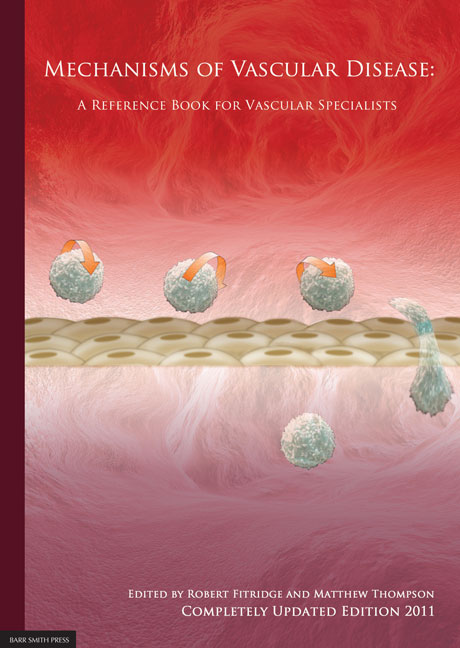Book contents
- Frontmatter
- Contents
- List of Contributors
- Detailed Contents
- Acknowledgements
- Abbreviation List
- 1 Endothelium
- 2 Vascular smooth muscle structure and function
- 3 Atherosclerosis
- 4 Mechanisms of plaque rupture
- 5 Current and emerging therapies in atheroprotection
- 6 Molecular approaches to revascularisation in peripheral vascular disease
- 7 Biology of restenosis and targets for intervention
- 8 Vascular arterial haemodynamics
- 9 Physiological Haemostasis
- 10 Hypercoagulable States
- 11 Platelets in the pathogenesis of vascular disease and their role as a therapeutic target
- 12 Pathogenesis of aortic aneurysms
- 13 Pharmacological treatment of aneurysms
- 14 Pathophysiology of Aortic dissection and connective tissue disorders
- 15 Biomarkers in vascular disease
- 16 Pathophysiology and principles of management of vasculitis and Raynaud's phenomenon
- 17 SIRS, sepsis and multiorgan failure
- 18 Pathophysiology of reperfusion injury
- 19 Compartment syndromes
- 20 Pathophysiology of pain
- 21 Post-amputation pain
- 22 Treatment of neuropathic pain
- 23 Principles of wound healing
- 24 Pathophysiology and principles of varicose veins
- 25 Chronic venous insufficiency and leg ulceration: Principles and vascular biology
- 26 Pathophysiology and principles of management of the diabetic foot
- 27 Lymphoedema – Principles, genetics and pathophysiology
- 28 Graft materials past and future
- 29 Pathophysiology of vascular graft infections
- Index
3 - Atherosclerosis
Published online by Cambridge University Press: 05 June 2012
- Frontmatter
- Contents
- List of Contributors
- Detailed Contents
- Acknowledgements
- Abbreviation List
- 1 Endothelium
- 2 Vascular smooth muscle structure and function
- 3 Atherosclerosis
- 4 Mechanisms of plaque rupture
- 5 Current and emerging therapies in atheroprotection
- 6 Molecular approaches to revascularisation in peripheral vascular disease
- 7 Biology of restenosis and targets for intervention
- 8 Vascular arterial haemodynamics
- 9 Physiological Haemostasis
- 10 Hypercoagulable States
- 11 Platelets in the pathogenesis of vascular disease and their role as a therapeutic target
- 12 Pathogenesis of aortic aneurysms
- 13 Pharmacological treatment of aneurysms
- 14 Pathophysiology of Aortic dissection and connective tissue disorders
- 15 Biomarkers in vascular disease
- 16 Pathophysiology and principles of management of vasculitis and Raynaud's phenomenon
- 17 SIRS, sepsis and multiorgan failure
- 18 Pathophysiology of reperfusion injury
- 19 Compartment syndromes
- 20 Pathophysiology of pain
- 21 Post-amputation pain
- 22 Treatment of neuropathic pain
- 23 Principles of wound healing
- 24 Pathophysiology and principles of varicose veins
- 25 Chronic venous insufficiency and leg ulceration: Principles and vascular biology
- 26 Pathophysiology and principles of management of the diabetic foot
- 27 Lymphoedema – Principles, genetics and pathophysiology
- 28 Graft materials past and future
- 29 Pathophysiology of vascular graft infections
- Index
Summary
INTRODUCTION
Atherosclerosis, the principal cause of heart attack, stroke, and peripheral vascular disease, remains a major contributor to morbidity and mortality in the Western World. Disease progression is slow, beginning in childhood and usually becoming clinically manifest in middle age or later. Although the aetiology of atherosclerosis is not fully understood, it is generally accepted that atherosclerosis is a multifactorial disease induced by the effects of various risk factors on appropriate genetic backgrounds. Many risk factors, such as hypercholesterolemia, modified lipo-proteins, hypertension, diabetes, infections and smoking have been identified in the development of atherosclerosis.
Atherosclerosis has been the focus of intense research for over 100 years. Since Anitschkow and Chalatow first reported that cholesterol can cause atherosclerosis, many investigators have intensively studied the role of blood cholesterol in the pathogenesis of atherosclerosis. Although formerly considered a bland lipid storage disease, new insights into the pathogenesis of atherosclerosis have emerged during the last decades, due to the progress of cellular and molecular approaches to the study of cell interactions in the arterial wall as well as alterations of lipid metabolism. These new insights were broadly summarized in three main theories, i.e. the ‘response to injury’, ‘oxidized low-density lipoprotein (LDL)’, and ‘inflammation’ hypotheses.
The response to injury hypothesis relies on the concept that the primary cause of atherosclerosis is an injury to the arterial endothelium induced by various factors, i.e. smoking, mechanical stress, oxidized-LDL, homocysteine, immunological events, toxins, viruses, etc.
- Type
- Chapter
- Information
- Mechanisms of Vascular DiseaseA Reference Book for Vascular Specialists, pp. 25 - 42Publisher: The University of Adelaide PressPrint publication year: 2011
- 1
- Cited by

